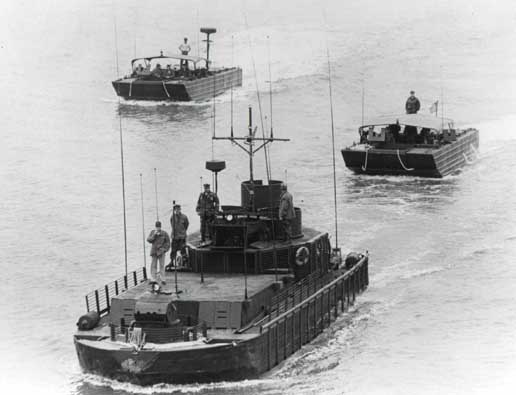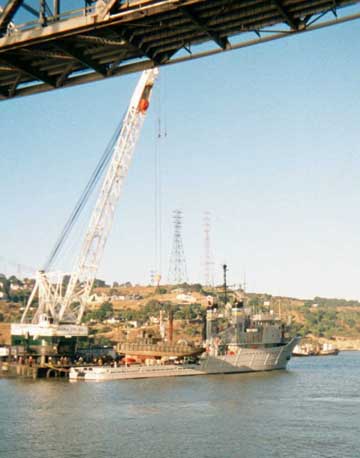Accolades and heartfelt thanks to those contributing to moving the CCB-18 to San Diego
Read here the story of how a former Swift boat sailor provided the jump start to bring CCB-18 to San Diego and how another former Swift boat sailor is working to insure that it becomes a part of the permanent static small boat “Brown Water Navy” display at NAB Coronado. Also how the Navy and Army again joined forces for yet another successful mission!!
It seems that lots of folks have been trying to see that CCB-18 got moved out of its Sacramento River Delta home to a permanent resting place in San Diego. Albert Moore (USS Benewah), President of the MRFA, was working with several great contacts. Retired Army Lt. General Pat Hughes was close to coordinating an Army lift of the CCB to San Diego when a former RIVDIV 91 commander sprung into action.
Frustrated by inaction and stories of how the Navy didn’t make port calls to San Francisco any longer, and knowing that something big needed to happen, MRFA Member Al Breininger, COMRIVDIV 91, called his old class mate, Admiral Harold W. Gehman, Jr., Supreme Allied Commander, Atlantic (SACLANT) and Commander-in-Chief, U.S. Joint Forces Command. Admiral Gehman, being a former Officer in Charge of PCF-27 (a Swift Boat), and later commander of a detachment of Swifts at Chu Lai, was quick to react… “Sure I’d like to help.”
A quick contact to Colonel Joseph Frankie, and then the Colonel’s call to Major Chris Craft. Others were contacted and another joint Army/Navy operation was underway. A training mission was soon scheduled for the USNS Sioux, a fleet tug out of San Diego. The ship’s Master Pat Huetter got underway and rendezvoused with the CCB-18 at Mare Island. Mike West, former USCG, and custodian of the CCB for the Naval Historical Center for the last several years, donated his time and money to hire the crane to lift the CCB aboard the Sioux (See picture at bottom of page). Straight to San Diego and right on time, Captain Huetter carried the precious cargo to the 32nd Street Naval Station where she was off loaded the next day.
Making arrangements in San Diego and of tremendous help was Bob St. Martin (USS Benewah), currently the SUPSHIP’s Supervisor of Small Boat Maintenance in San Diego. Bob contacted CDR W. C. Hammil, the CO of Assault Craft Unit One for permission to tie the boat up to one of ACU1’s piers until official arrangements could be made for the restoration of the boat at the Amphibious Base by yet another former Swift boat sailor, Ken McGhee, CAPT USN (Ret.) and former Commander of Coastal Squadron One.
West coast board members Jim Steffes and Don Blankenship will coordinate the restoration. Jim, another former Swift boat sailor (PCF-12), ably coordinated the restoration effort of PCF-104, which is being dedicated by the Swift Boat Sailors Association at their reunion in San Diego on Veteran’s Day 2000.
With the help of Ken McGhee working through the Navy’s Public Affairs Officer Ken Mitchell, and all of the commands at North Island Naval Air Station and Naval Amphibious Base, Coronado, we hope to soon place the CCB-18, representing Task Force 117, in its final resting place along side the Swift Boat (PCF-104) representing Task Force 115, and a PBR representing Task Force 116.
Captain Edward C. Bowen, Commanding Officer of Special Warfare Center, has been extremely supportive by providing the Memorial site’s land under his jurisdiction at CISM field. Captain Bowen recognized the significance of the link between the active duty small craft personnel of today’s Navy with those of us who wrote new chapters in Naval small craft history in Vietnam. He continually invites us “old timers” to the graduation ceremonies of the Special Warfare Combatant Craft Crewman, who go on to devote their careers in the Navy to assault craft of all types. We have a chance to interact with the young sailors and they, along with their instructors, show a tremendous interest in the roots of the Brown Water Navy.
Thanks also to Mark Wertheimer of the Naval Historical Center for his support in this project allowing permanent custody of the CCB to flow to the Mobile Riverine Force Association. And many thanks to the NHC for its efforts to preserve the history of the United States Navy.
Accolades would not be complete without thanking Ralph Fries and his persistent effort to complete the Vietnam Unit Memorial and Small Boat Display. His tireless contribution to this dream which all of us share will soon be realized, especially with the help of your contributions to this extremely important historical preservation project. And thanks to Everett Jones, former Boat Captain of CCB’s 151-4 and 152-5, for taking off on a moment’s notice from his home in Chula Vista to San Francisco to video the pick up of CCB-18, and hopping quickly back to San Diego to video the arrival and off loading here. Everett will be a key restoration committee member here responsible for aiding in the coordination of the CCB’s restoration.
I am relatively certain I have probably slighted others who deserve our sincere appreciation. Believe me it is definitely not intentional. If you are aware of anyone that should be included here, please notify me (db1@rivervet.com) as soon as possible so that I may correct my oversight.
Don Blankenship
Mike West adds the following:
I think that you should know some of the history of the CCB at the American Patrol Boats Museum.
In November of 1995 we were put in contact with the Naval Historical Center. We were told by them that the MRFA had submitted a letter telling them that they could not move the CCB and as such were releasing any claim to the vessel and leaving it to the Navy as to the disposition. We were informed by the Navy that the vessel was to be scraped if they did not find a home for it by December 15th.
APBM looked at the boat, which was found laying on the ground, and jumped in to action to save it. As we found no early support from the Navy we hired our own welder and set to working on the hull. The turret’s had been removed and had to be located. Almost half of the bar armor was missing. The boat had not seen paint in many years. engine hatches were not in place and were found in a scrap pile. Because the short amount of time allowed to make repairs the welder had to patch over some areas and use some of what the Navy HT had started with. There was still 1000 gals of used diesel that had to be removed. After the bottom was painted and repairs made the boat was put in to the water and it was found that there was over 1500 gals of rain water in the voids. As always, none of this would have happened if it were not for the help of all those who come out of the wood work to help save these great bits of history.
The boat was then towed to Rio Vista by the museum. Although not one of the main projects of the museum many repairs were made to the vessel over the 4 1/2 years it was at the museum. Including welding of the forward hatch, a 4 month long project to clean and remove loose paint and seal with new paint in the area between the engine room and command center, and installing new bolts in the lazerette hatch plus many other items.
The boat had to be tended almost 24 hours a day during time of floods when the water of the Sacramento river reached nearly 10 knots of speed. Never did one day go by when the boat was left unchecked by someone.
As to moving the boat on our end, your thanks should go to Mr. John Lucas of Lucas Marine Construction. He not only paid for the tug Doris L. to move the boat from Rio Vista to Vallejo but also paid for the crane and the crane crew wages. The tug was run by myself and Jim West at no charge to the company. This had to be done after work hours. I spent countless hours to set up all the details.
I have included photos from the lift of the vessel in Vallejo. The lift was made at the building site of the new Carquinez Bridge and not Mare Island. The lift was made by Durta Crane.
Mike West


